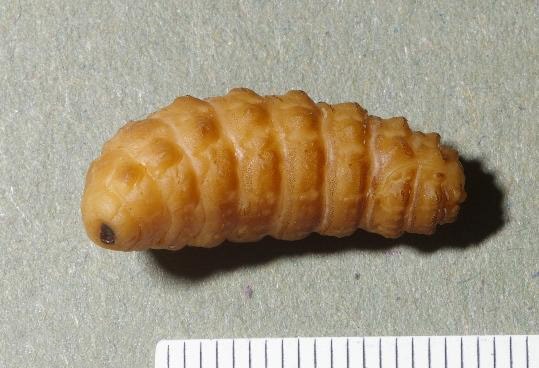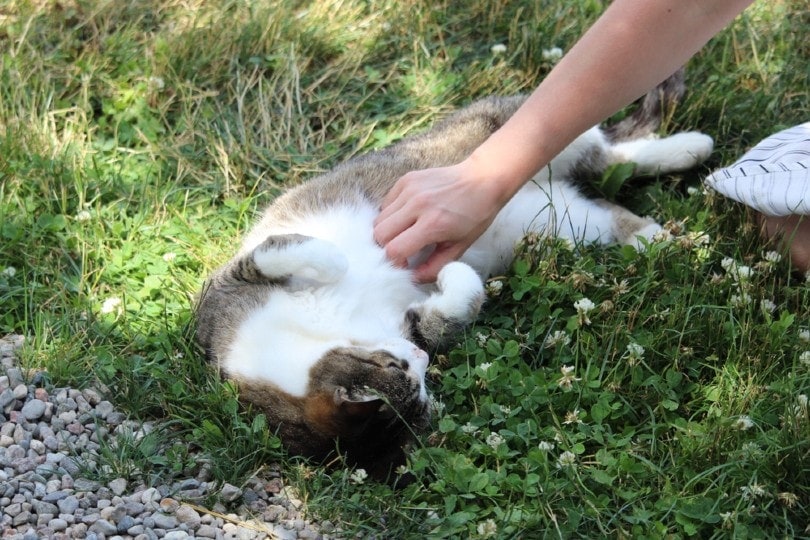Warbles (Wolf Worm) in Cats: Vet-Reviewed Signs, Causes, & Care
Updated on

Click to Skip Ahead
Cats are curious creatures. They wander, investigate, snoop about in random places, and can often find themselves in a spot of mischief, especially those who are hunters. Unfortunately, they can end up with more than the prize they were after, like a warble or wolf worm.
Warbles (wolf worm, botfly) is the frequent name used for the parasite known as Cuterebra. Whilst no pet parent likes the idea of a worm wriggling about in their cat’s skin, if you discover a strange lump on your cat, particularly on the head or neck area, or swelling around their nose, a warble could be the culprit.
What Are Warbles?
Warbles is the term given to a lump or swelling under the skin caused by botfly larvae. A small hole can be seen in the center and within it contains a maggot-like botfly larva. Warbles are a type of botfly larvae and are found in abundance all over North America. However, the botfly is an opportunistic parasite, meaning, they can temporarily take up residence on a different host to their usual choice of rodent or rabbit in order to carry out their life cycle successfully and efficiently. Cats are a common and easy option.
As adults, they are large and fuzzy flies, but it isn’t the adult flies that cause all the damage, it’s the larvae, and they are super common around late summer and fall. The botfly larvae are part of a cycle to create the end result of an adult fly.
Where Do the Harmful Larvae Come From?
The life cycle of Cuterebra is relatively simple. An adult fly lays a batch of approximately 5–15 eggs typically around the entrances to rabbit and rodent burrows or in long grasses. When a cat is nearby, the cat’s body heat activates the eggs to hatch into the next stage of the fly cycle-–the larvae. The larvae attach themselves to the fur of an unsuspecting cat who happens to be walking close by.
Once the larvae are on their coat, they infiltrate your cat’s skin via any opening into the cat’s body, for example, nostrils, mouth, wounds, grazes, and other offices, and begin to migrate and travel to other areas of the body. Once under the tissues of the skin, the larvae remain in place, making a small hole in the skin in order to breathe.
After approximately 30 days, the larva falls out of the host and into the environment where it becomes a pupa before transforming into an adult fly. The whole cycle then starts again.
What Are the Signs of Warbles?
Botfly infestations of cats are common, and one or more of the following signs may be noticed depending on the body area affected. In rare cases, the larvae can journey to more problematic areas of the body such as the nose, eyes, or throat. They can even reach the spinal cord and brain, causing issues with the central nervous system. Typically, it is the head and neck region that are most afflicted. Some signs include:
- A swelling or lump under the skin commonly found on the head and neck area, nose, mouth, under the belly, and paws
- The swelling may be red
- A hole can be seen in the center of the lump
- Pain may or may not be present
- Pus (infection) discharge may or may not be present
- Excessive grooming
- Matted fur around the area
- Hair loss
- Lethargy
- Poor demeanor
- Abnormal body temperature (too high or too low)
If in the nose:
- Sneezing
- Coughing
- Discharge
- Swelling around the nose
- Increased respiration rate
- Difficulty or changes in breathing
If in the eye:
- Pinkish/red eye
- Eye squinting
- Swelling of surrounding tissues
- Discharge
If affecting the central nervous system (CNS):
- Walking in circles
- Wobbling
- Head pressing
- Blindness
- Fits/seizures
- Head tilt
- Abnormal gait
How Does a Cat Get Warbles?
As cats are accidental hosts of botflies, any cat allowed outdoors or that is a roaming feline is at risk, particularly if they hunt rodents or hang around in areas with long grass. The inquisitive feline becomes contaminated with the egg(s) previously laid, as they stick onto their fur or face. Cats have a habit of poking their heads into places of interest, so faces can be a prime target. This process can happen to both male and female cats of any age.
The time of year is also relevant as botflies are not active in the wintertime unless you live in a country or region with warm winter climates.

How Do I Care for a Cat with Warbles?
This will be case-dependent on whether the larva is still present in the warble or if it has already fallen off into the environment. However, in both cases, veterinary assistance will usually be required.
If the larva has already left the warble, the area is flushed and cleaned, and any injured tissue will be surgically removed. A course of antibiotics will be prescribed. If the larva is still present, the larva will be removed under anesthesia in one piece via a surgical incision, and any injured or infected tissue is debrided (cut away) to allow the healthy tissues to heal. Antibiotics are most likely given to prevent secondary infections.
Some veterinarians may choose to fill the breathing hole with a liquid to prevent the larvae from breathing, which, as the botfly tries to escape, can be grasped with forceps, and removed.
If you suspect a warble or find a suspicious lump, take your cat for a check-up with your veterinarian—do not try to treat a warble at home. It is imperative the whole larva is removed in one piece and a visit to your veterinarian is necessary for its safe removal to prevent further problems.
Frequently Asked Questions (FAQ)
Can a human catch warbles?
There is a possibility of eggs attaching to human skin hair or human hair as happens with cats, but it is exceptionally rare. Once the botfly is inside the cat’s body, it cannot be transmitted to another animal or a human.
Can I remove a warble at home?
No. Trying to remove the warble or worm at home or “squeezing” it carries a high risk of leaving part of the larva behind or crushing it. Both instances can lead to severe problems such as infection and anaphylaxis reactions.
What can a warble be mistaken for?
Understandably a warble can be mistaken for an abscess such as those seen following a cat bite. A foreign body stuck under the skin for example a grass seed or small splinter of wood will also create similar signs.
Conclusion
Parasites are common organisms amongst cats and par for the course of pet ownership, and although unpleasant and unsightly, for the most part, they are either preventable or treatable. Warbles are common but require treatment as soon as they are noticed, and the outlook is good for your cat following the correct care plan. Unfortunately, the only way to prevent your cat from getting a warble in the first place is to keep your cat indoors, but it is worth talking to a veterinarian about using a regular parasiticide. These are medications to prevent parasitic infections however, the jury is still out on the effectiveness of these against warbles.
Featured Image Credit: Hypoderma-larva, Alan R Walker, via Wikimedia Commons CC SA 3.0 Unported












